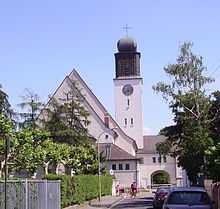Streets and squares in Ludwigshafen am Rhein / C
Carl-Auer-Strasse
67063 Ludwigshafen-Friesenheim
Carl Auer von Welsbach was an Austrian chemist and entrepreneur. He was the founder of Treibacher Industrie AG and the Auer Society in Berlin.
Carl-Auer-Straße is a connecting street between Bremserstraße and Benzstraße.
Carl-Bosch-Strasse
67063 Ludwigshafen-Friesenheim
Carl Bosch was a military economic leader in the Third Reich. In 1931, Bosch and Friedrich Bergius received the Nobel Prize in Chemistry “for their services to the discovery and development of high-pressure chemical processes”.
Carl-Bosch-Strasse was laid out in the middle of the 19th century in connection with the construction of the Badische Anilin- & Soda-Fabrik. In 1885 it was called Friesenheimer Strasse until it was renamed in 1962 after the BASF chemist Carl Bosch.
It originally began on Von-der-Tann-Strasse until the first section was renamed Dessauer Strasse in 1989.
Carl-Clemm-Strasse
67063 Ludwigshafen-Hemshof
Carl Clemm was a German entrepreneur and politician.
Carl-Friedrich-Gauß-Strasse
67063 Ludwigshafen-Hemshof
Carl Friedrich Gauß was a German mathematician, astronomer, geodesist and physicist with a wide range of interests.
Carl-Wurster-Platz
67063 Ludwigshafen-Hemshof
Carl Wurster was a German chemist and military economist. He was on the board of directors of the German Pest Control Society (Degesch), which was involved in the manufacture of Zyklon B as a patent holder .
In the IG Farben trial in 1948, Wurster was acquitted on all counts. After BASF AG was re-established in 1952, Wurster was appointed chairman of the board.
Carolistrasse
67067 Ludwigshafen-Rheingönheim
The Rheingönheim pastor Wilhelm Caroli was sentenced by the National Socialists to eight months in prison for pulpit abuse in 1937 and starved to death in Dachau concentration camp in 1942 .
Carolistraße, formerly Kirchstraße, is a street that branches off from the main street in Rheingönheim to the north.
The Catholic Sankt Josephskirche stands on Carolistraße , which was built in 1914 and 1915 as an early work by the Würzburg architect Albert Boßlet . It was destroyed by air raids in World War II and reopened in the 1950s.
Christian-Weiss-Strasse
67059 Ludwigshafen-West
Christian Samuel Weiss was a mineralogist and crystallographer.
Christian-Weiß-Straße runs parallel to Teufelsbrücke (Schänzeldamm) from Bruchwiesenstraße to the southeast.
Christine Teusch facility
67067 Ludwigshafen-Rheingönheim
Christine Teusch was a politician of the Center Party and the CDU and Minister of Education in North Rhine-Westphalia.
The Christine-Teusch-Anlage is a street in the south of the Rheingönheim district.
Christoph-Kröwerath-Strasse
67071 Ludwigshafen-Notwende
Christoph-Kröwerath-Straße is a street in the east of the Notwende district .
Claudiusstrasse
67067 Ludwigshafen-Rheingönheim
Tiberius Claudius Caesar Augustus Germanicus was the fourth Roman emperor of the Julio-Claudian dynasty.
Claudiusstraße is a street in the southwest of the Rheingönheim district. The street name is reminiscent of Rheingönheim's Roman past.
Clodwigweg
67071 Ludwigshafen-Ruchheim
Clovis I was a Frankish king from the Merovingian dynasty .
The Clodwigweg is a path in the southeast of the Ruchheim district .
Comeniusstrasse
67071 Ludwigshafen-Oggersheim
Johann Amos Comenius was a Czech philosopher, theologian and educator.
Comeniusstraße is a street in the Oggersheim district that leads away from Raiffeisenstraße and then joins Adolf-Diesterweg-Straße.
The Protestant Comenius Church , which was built in 1968 by the Mannheim architect Helmut Striffler , is located on Comeniusstrasse .
Cordovastrasse
67071 Ludwigshafen-Oggersheim
Cordovastraße is a street between Schillerstraße and Niedererdstraße in Oggersheim. It is named after the Spanish general from the Thirty Years War named Gonzalo Fernández de Córdoba , who plays a major role in the story of Hans Warsch . Don Cordova was commissioned by the Emperor to take the Palatinate in 1621. When he was preparing to besiege the city of Frankenthal , he camped near Oggersheim , whose wealthier residents all fled to Mannheim with their belongings . The poorer residents also eventually fled.
So only the shepherd Hans Warsch remained in town with his heavily pregnant wife and his family. Warsch agreed the terms of the surrender on the condition that his family would be spared. When this was promised to him, he opened the city gate and let the Spaniards move in. Some time later Hans Warsch's wife had a child, whom Don Cordova took over.
Croissant Rust Street
67065 Ludwigshafen-Mundenheim
Anna Croissant-Rust was a writer who moved with her husband, the engineer Hermann Croissant, to Ludwigshafen in 1895, where her husband had been entrusted with the management of a gas works.

